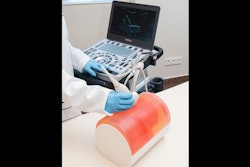
An ultrasound curriculum with phantom training doubled the knowledge of radiation oncology residents when it came to gynecologic interstitial brachytherapy, according to research published December 4 in Brachytherapy.
A team led by Dr. Jay Shiao from the University of Colorado Cancer Center found that residents showed agreement in the curriculum being an effective learning experience.
"This low-cost and effective training curriculum can be replicated at other programs or American Brachytherapy Society meetings," Shiao and colleagues wrote. "This curriculum will likely be particularly helpful for institutions that have a lower volume of interstitial brachytherapy gynecologic cases."
Brachytherapy and chemoradiation are the standards of care when it comes to treating cervical cancer. While the former has shown benefits such as improved pelvic control, the ability to escalate radiation dose to the tumor to optimize local control, and the ability to spare radiation to normal tissue, its use has decreased in recent decades.
Shiao and colleagues said that while "many" factors may be contributing to this decrease, they focused on procedural technique comfort.
"For example, in a survey of radiation oncology residents, 40% reported inadequate exposure of brachytherapy in their training," they said.
Shiao et al wanted to see if hands-on simulation training with ultrasound would help radiation oncology residents improve information retention, understanding, and confidence in interstitial brachytherapy procedures. They also wanted to use a low-cost phantom model.
After a lecture, two alternating workshops were performed. The first one consisted of a hands-on ultrasound-guided interstitial brachytherapy workshop. Here, one resident imaged the phantom with a transabdominal ultrasound probe and another resident implanted the phantom with needles. A second session consisted of a hands-on treatment planning workshop using a 3D treatment planning system (BrachyVision, Varian).
The cost in materials for each phantom was about $66, compared with the $200 to $7,000 range seen in anthropomorphic ultrasound phantoms. The study authors said the phantoms had a shelf life of about one month of stability from construction to workshop use. Each phantom was used by multiple residents in each workshop.
Four of the seven medical residents that participated in this curriculum had prior brachytherapy experience. Residents reported significantly improved knowledge regarding equipment and procedure in evaluating gynecologic anatomy using ultrasound, CT simulation, contouring, and plan review (p < 0.01).
Residents showed improvement in answering knowledge-based questions correctly, increasing from 44% correct at the start of the curriculum to 88% after completion (p < 0.01). All residents either agreed or strongly agreed that the curriculum was effective.
The researchers said while this curriculum was specifically designed for training of gynecologic interstitial brachytherapy, it can supplement the benefits of other brachytherapy curriculums.
"Additional strategies to this initiative should be considered to standardize radiation oncology education initiatives for gynecologic interstitial brachytherapy training," they added.
The study authors concluded that this hands-on training would benefit training radiation oncology residents, instructors, and patients.




















